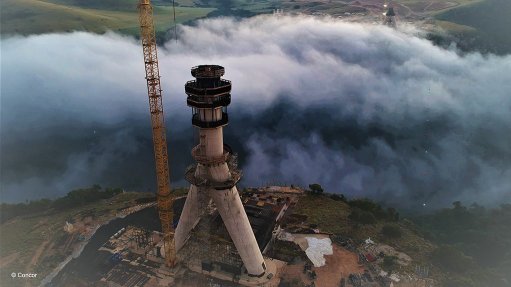
Photo by: Concor
Name of the Project
N2 Wild Coast Toll Road (N2WCTR) megabridge project – Msikaba bridge.
Location
The bridge will be built over the Msikaba river gorge near Lusikisiki, in South Africa’s Eastern Cape province.
The Msikaba bridge is located on the N2, which connects the Western Cape, Eastern Cape, KwaZulu-Natal and Mpumalanga provinces, and traverses the cities and major towns of Cape Town, George, Gqeberha (formerly Port Elizabeth), East London, Mthatha, Durban and Ermelo. This includes a new greenfield section of 112 km between Port St Johns and Port Edward, including the two megabridges and several additional major river interchange bridges.
Only the new greenfield section of the project will be tolled. None of the sections between East London and Mthatha or between Mthatha and Ndwalane, near Port St Johns, will be tolled.
Project Owner/s
South African National Roads Agency Limited (Sanral).
Project Description
The Msikaba bridge forms part of the N2WCTR project.
The 580-m-long bridge will be the longest main span bridge in Africa – built using the cable-stayed method – and the second-longest main bridge span in Africa after the Maputo-Catembe suspension bridge, in Mozambique. With a deck height of 194 m above the river valley, Msikaba will become the third-highest bridge in Africa and the 133rd-highest in the world. The cable-stay design will ensure that the construction of the bridge will have no direct impact on the pristine gorge environment almost 200 m below, which is one of the environmental requirements for building the bridge.
The bridge is being built from the north and south banks of the gorge and comprises two identical halves, each spanning 290 m, which will meet midpoint over the gorge.
Each half is supported by 17 pairs of cables attached to the inverted Y-shaped pylons, one on each side of the gorge.
The pylons are back-stayed into the anchor blocks, two on either side of the gorge, by 34 pairs of cables – 17 for each half – positioned 130 m behind each pylon.
Each anchor block is 49 m long, 10 m wide at the base (narrowing to 4 m on the spine of the structure), 17.2 m deep, and a mass of 21 500 t.
Potential Job Creation
About R86-million of the contract value has been allocated to targeted local labour and R515-million for subcontracting to targeted enterprises.
To date, R553-million has been spent on 157 targeted enterprises comprising 44 suppliers, 52 service providers and 61 subcontractors. About R93-million has been spent on wages for local labour, in addition to the targeted spend.
Of the 453 full-time-equivalent jobs that have been created on the Msikaba bridge to date, 391 are occupied by locals.
Capital Expenditure
The Msikaba bridge project will cost an estimated R1.75-billion.
Planned Start/End Date
Construction is expected to be completed in 2025.
Latest Developments
Construction on the Msikaba bridge is progressing, with several challenging technical activities to be tackled.
These include post-tensioning the anchor blocks, installing pylon inserts and building the ladder deck.
“The last two years have been spent completing the four 21 000 t anchor blocks and progressing the elegant bridge pylons on each side of the gorge,” explains Concor project director Laurence Savage.
The project is now entering technically challenging phases, the first of which is the post-stressing of the anchor blocks to ensure that the transfer of load exerted by the stay cables is well distributed through the blocks.
Embedded 14 m deep into each block, the post-stressing is profiled as a large U-shape to mobilise the dead mass of the anchor block being pulled up by the stay-cable at the top. The post-stressing option is a modern and efficient strategy that reduces the need for reinforcement steel, which could have congested the blocks and made it difficult for the concrete to fill all the voids.
The locally procured post-tensioning strand cables at the 17 anchor points in every block are stressed up to around 500 t by a specialist company. The process is expected to take two to three weeks for every anchor point.
The next major step involves installing pylon inserts into the pylon’s structure as it rises above the 86 m mark.
There are 17 inserts for every pylon; these are steel rings weighing 8 t to 10 t each, which are concreted into place, one after the other, until the pylon reaches a height of about 122 m. The pylon inserts are used as the anchors from which the cables run as back-stays to the anchor blocks and as fore-stays to the bridge deck.
Savage has said that not all the inserts need to be in place before the launching of the deck can start. Careful planning will allow for the deck launching – a highly technical task – to start after the first five inserts are installed, which is likely to be in the second half of 2024.
Another demanding aspect of the bridge’s latest phase will be the construction of the ladder deck. It is the first steel deck segment of the bridge and, will, therefore, be cast in concrete into the foundation of the pylon, and will be the largest continuous pour on site.
About 700 m3 of concrete will be cast in a single pour, with a very strong 65 MPa mix. This will also demand a high density of reinforcement steel weighing 160 t.
Key Contracts, Suppliers and Consultants
Concor Mota-Engil, a JV between Concor Construction and MECSA Construction (Msikaba bridge contract); HVA Joint Venture (Msikaba bridge consultants comprising CH2M and SMEC; ERO Engineers (lead consultant – Ntafufu to Bambisana turn-off); Naidu Consulting (lead consultant – Bambisana turn-off to Lingeni); Aurecon Rohm consortium (lead consultants – Lingeni to Msikaba); and Knight Piésold (lead consultant – Msikaba to Mtentu), KBK (lead consultant – Mtentu to Kulumbe), and V3 Consulting (lead consultant Kulumbe to Mtamvuna); V3 Consulting (lead consultant – Ndwalane to Ntafufu and Kulumbe to Mtamvuna river).
Contact Details for Project Information
Sanral, email pressoffice@nra.co.za.